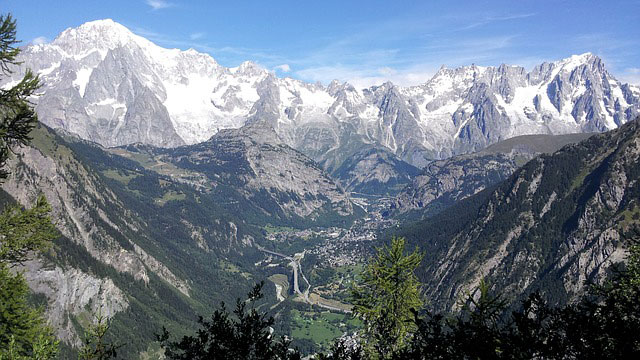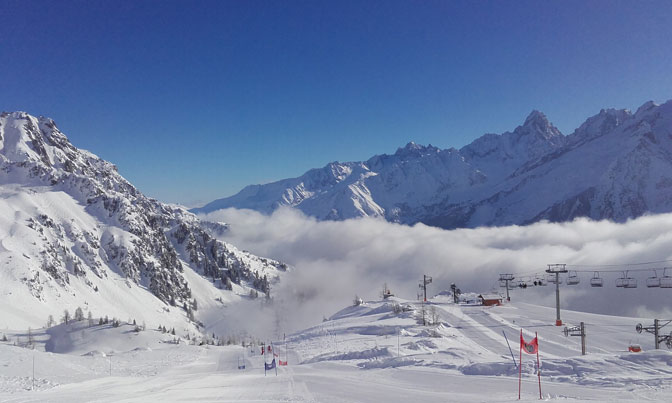
With its steep valleys, breathtaking views and high peaks, the Alps attracts nature lovers and winter sport enthusiasts from across the globe. About 120 million people visit the Alps each year.
The tourism business may be booming, but the very thing that draws people to this unique part of the world is being threatened by increased urbanization and mass tourism.
The Dangerous Effect of Mass Tourism
Tourism is a top industry in the Alps, but the sheer number of tourists that visit the region each year are contributing to the destruction of its pristine wildlife areas.
- Tourist resorts have high consumption rates
- Increased motor traffic creates more pollution
Adventure sports, such as canyoning, mountain biking and paragliding, are now reaching areas of the Alps that were once untouched by tourists. As a result, humans are encroaching on wildlife habitats and threatening biodiversity in the region.
One of the most destructive tourist activities just so happens to be one of the most popular: skiing. There are more than 300 ski resorts in the Alps with 10,000 transport facilities.
Most people don’t realize that the construction of a ski resort causes permanent damage to the landscape. The use of snow canons further harms the environment because of the energy, water, biological additives and chemicals used.
The Threat of Urbanization
Tourism breeds urbanization, which is another growing threat to the Alp region. Urban areas are expanding, and wildlife in the valley is in danger.
In some Alpine valleys, the damage is already done. Some of these areas have already lost nearly all of their biodiversity value.
Valleys of the Rhine, Rhone, Adige and Inn rivers have been hit particularly hard and have lost most of their biodiversity.
Expanding settlements in the valley bottoms are destroying natural habitats, including wetlands, floodplain forests, alpine steppes and riverbeds.
While transportation infrastructure is great for humans, it prevents many localized species from developing ecological networks.
Residential homes are further threatening the natural beauty of the Alps. Since 1950, homes have nearly doubled in size. While population growth has been minimal, the number of residential properties has increased significantly. Add this to the fact that the Alps is not an easy place to live.
Cold winters and high altitude mean that homes require more heating than average. And the hard water in the region makes the heating systems of many homes even more inefficient, requiring some of the best water softeners in some cases.
As cities and even small villages expand, even the most remote areas of the Alps are under the threat of urbanization.
Holding Business Accountable

Winter tourism in the Alps brings in $66 billion each year. With such a huge industry, many businesses want to sweep the problem under the rug.
To make matters worse, there are no international environmental standards for these resorts to adhere to. It is up to individual resorts and national regulations to set standards and lead the way.
Now, resorts and local authorities are taking the threat of urbanization and subsequent climate change seriously. The more people that move to and through the Alps, the more pollution and the greater the destruction to wildlife and biodiversity.
Six years ago, the Alps saw one of the warmest winters on record. Over the last decade, the region saw three of the warmest years in 500 years.
But there are other organizations that are working hard to help preserve the Alps and protect the region from the effects of urbanization.
What’s Being Done to Preserve the Alps?
The World Wildlife Federation has taken steps to help preserve the natural beauty of the Alps, and continues to make the Alpine region a priority for preservation.
The WWF has identified the Laghi Insubriei area of Italy and Switzerland to be one of the most critical areas to focus on and will use this area to test out its conservation efforts. The organization is focusing on three main habitats: rivers, dry meadows and forests.
The WWF is working to help restore the dry meadows on the slopes of Monte Generoso to restore the local cultural heritage and to enhance the area’s rich wildlife.
In the Vedeggio River, the WWF is working to help establish an ecological network.
The organization is also working to help restore and protect forest habitats. Most importantly, the WWF is focusing on chestnut orchards, coppice forests and species-rich forests.
Along with local habitats, efforts are also underway to restore populations of large carnivores, including the lynx, the bear and the wolf.
To save the rivers, efforts are being made to establish a new river basin management plan for the Upper Traun River, restore the Rhine River and recreate floodplains near the Inn River.